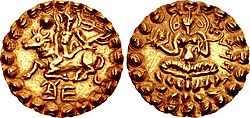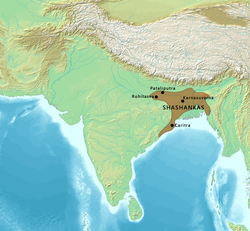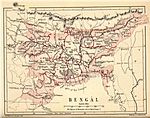| Kingdom of GauḍaGāuṛa Rājya | |||||||||||||
|---|---|---|---|---|---|---|---|---|---|---|---|---|---|
| c. 4th century AD (pre-Gupta) 554–626 750–1230 | |||||||||||||
 Coin of Shashanka, king of Gauda, circa 600–635. Samatata type, Assam mint.
Coin of Shashanka, king of Gauda, circa 600–635. Samatata type, Assam mint.
| |||||||||||||
 Map of the Shashankas or "Gauda Kingdom", circa 600 CE. Map of the Shashankas or "Gauda Kingdom", circa 600 CE. | |||||||||||||
| Capital | Karnasuvarna (present day Murshidabad district, West Bengal, India) | ||||||||||||
| Religion | Hinduism (Shaivism) | ||||||||||||
| Government | Monarchy | ||||||||||||
| Maharajadhiraja | |||||||||||||
| • 554–590 | Jayanaga | ||||||||||||
| • 590–625 | Shashanka | ||||||||||||
| • 625–626 | Manava | ||||||||||||
| |||||||||||||
| Today part of | India Bangladesh | ||||||||||||
The Gauḍa kingdom (Gauṛa Rājya) (Bengali : গৌড় রাজ্য) was a kingdom during the Classical era in the Indian subcontinent, which originated in the Gauda region of Bengal (modern-day West Bengal and Bangladesh) in 4th century CE or possibly earlier.
Location and extent
A Buddhist Mahāyāna Text Mañjuśrī-Mūlakalpa records the existence of Gauda kingdom in Bengal before it was replaced by Gupta Empire in the 4th century. King Loka who was born in Vardhamāna (Bardhamān) is mentioned who must have ruled in the early 4th century CE.
King Shashanka is often attributed with creating the first separate political entity in a unified Bengal called Gauda. He reigned in 7th century, and some historians place his rule approximately between 590 and 625. His capital was at Karnasubarna, 9.6 kilometres (6.0 mi) south-west of Baharampur, headquarters of Murshidabad district. The Chinese monk, Xuanzang (Hiuen Tsang) travelled from the country of Karnasubarna to a region in the present-day state of Orissa ruled by Shashanka. There is mention of Pundravardhana being part of Gauda in certain ancient records. Not much is known about the early life of Shashanka. Historian D K Ganguly is reported to have concluded that he was a native of Magadha. The same source reports that the historian Padmanath Bhattacharya took Shashanka to be a son of Mahāsenagupta. R D Banerji concluded that he was descended from the Magadha Guptas. Nagendranath Basu has argued that Shashanka was the son / descendant of Raja Karnadeva, who founded the city of Karnasubarna in Bengal.

 South Asia
South Asia600 CE
KUNDINASPALLAVASALUPASNEZAKSALCHONSKALINGASPANDUVAMSHISGAUDASHAILODBHAVASGONANDASKANNAUJTAKKAWESTERN
TURKSTOCHARIANSVALABHISINDHMANDAVYA-
PURALATER GUPTASTHANESARCHALUKYASEARLY
KALA-
CHURISPERSIAN
EMPIREclass=notpageimage| Location of the Shahshankas and fragmented South Asian polities circa 600 CE, after the retreat of the Alchon Huns.
In some sources, Shashanka is described as a tribal leader of Bengal. Shashanka's name appears in multiple forms, including Śaśānka and Śaśānka-deva. The name is derived from Sanskrit, as another name for the Moon. Śaśānka-deva therefore loosely translates to "moon god".
The Hindu god Shiva bears the epithet Shashankasekhara, meaning, "he who bears the moon". The Chinese monk Xuanzang's writings, he is mentioned as She-Shang-Kia. He is also called Śaśānka Narendragupta, which initially lent credence to the claim that he was descended from the later Guptas. In Sinha's Dynastic History of Magadha, the names 'Śaśānka' and 'Soma' are used interchangeably. Some historians believe that Shashanka began his career as a feudatory chief (maha samanta) under Mahasenagupta, of the Later Gupta Dynasty. And that after the death of Mahasenagupta, Shashanka drove the later Guptas and other prominent nobles out of the region and established his own kingdom with his capital at Karnasubarna. Other historians like Sailendra Nath Sen is of the opinion that Mahasenagupta - already under pressure from the Maukharis (for failing to provide adequate protection) - wouldn't have knowingly appointed Shashanka to such an important position. Middleton (2015) argues in a similar vein that Shashanka served as maha samanta to a Gauda king, possibly Jayanaga. Whether Shashanka was a feudatory under the Maukharis or the Guptas is not known. By 605 C.E. following Mahasenagupta's death, Shashanka had established what became known as the Gauda kingdom. From there, he issued gold coins to celebrate his triumph, and came to be addressed as Maharajadhiraja (king of great kings). According to some sources the city of Gauda was founded by King Shankaladeva. He, originally, was a native of Kannauj. In the book, History of Hindostan (originally translated from the book Gulshan-i-Ibrahimi written by Firishta), it has been stated that Shankaladeva (Sinkol) was a native of Kannauj (Kinoge) and established the city of Gauda during the 8th century BC. Following his death, Shashanka was succeeded by his son, Manava, who ruled the kingdom for eight months. However Gauda was soon divided amongst Harshavardhana and Bhaskarvarmana of Kamarupa, the latter even managing to conquer Karnasuvarna.
Evidence is inconsistent regarding links of Gauda with the Rarh region. While Krishna Mishra (11th or 12th century), in his Prabodha-chandrodaya, mentions that Gauda Rashtra includes Rarh (or Rarhpuri) and Bhurishreshthika, identified with Bhurshut, in Hooghly and Howrah districts, the Managoli inscription of the Yadava king Jaitugi I distinguishes Lala (Rarh) from Gaula (Gauda).
According to Jain writers of the thirteenth and fourteenth centuries, Gauda included Lakshmanavati in present-day Malda district.
The Pala emperors were referred to as Vangapati (Lord of Vanga) and Gaudesvara (Lord of Gauda). Sena kings also called themselves Gaudesvara. From then Gauda and Vanga seem to be interchangeable names for the whole of Bengal.
See also
| Part of a series on the |
|---|
| History of Bengal |
 |
| Ancient Kingdoms |
| Classical Dynasties |
| Islamic Bengal |
| Colonial Bengal |
| Post-partition era |
Modern period
|
| Related |
References
- Schwartzberg, Joseph E. (1978). A Historical atlas of South Asia. Chicago: University of Chicago Press. p. 146, map XIV.2 (b). ISBN 0226742210.
- ^ Majumdar, R. C. (1971). History of Ancient Bengal. Calcutta: G. Bhardwaj & Co. pp. 6–8. OCLC 961157849.
- ^ Ghosh, Suchandra (2012). "Gauda, Janapada". In Islam, Sirajul; Jamal, Ahmed A. (eds.). Banglapedia: National Encyclopedia of Bangladesh (Second ed.). Asiatic Society of Bangladesh.
- K. P. Jayaswal (1934). An Imperial History Of India. p. 34.
- K. P. Jayaswal (1934). An Imperial History Of India.
- Bandopadhyay, Rakhaldas, Bangalar Itihas, (in Bengali), first published 1928, revised edition 1971, vol I, p 101, Nababharat Publishers, 72 Mahatma Gandhi Road, Kolkata.
- Sinha, Bindeshwari Prasad (1977). Dynastic History of Magadha. India: Abhinav Publications. pp. 131–133. Retrieved 16 September 2019.
- Basu, Nagendranath (1937). Bonger Jatiya Itihash (Kayastha Kando). India. p. 63. Retrieved 26 September 2019.
{{cite book}}: CS1 maint: location missing publisher (link) - Schwartzberg, Joseph E. (1978). A Historical atlas of South Asia. Chicago: University of Chicago Press. p. 26,146. ISBN 0226742210.
- "Kingdoms of South Asia – Indian Kingdom of Bengal". historyfiles.co.uk. Retrieved 19 September 2019.
- "Indian Antiquary". Journal of Oriental Research (Ed. J.A.S. Burgess). VII. Popular Prakashan: 197. 1878. Retrieved 16 September 2019.
- Sen, N. S. (1999). Ancient Indian history and civilization (Second ed.). India: New Age International. ISBN 81-224-1198-3. Retrieved 15 September 2019.
- Middleton, John (2015). World Monarchies and Dynasties. Routledge. p. 330. ISBN 9781317451587. Retrieved 15 September 2019.
- Firishtah, Muḥammad Qāsim Hindū Shāh Astarābādī (1803). The History of Hindostan,: Translated from the Persian. Vernor and Hood, Cuthell and Martin, J. Walker, Wynne and Scholey, John Debrett, Blacks and Parry, T. Kay, and J. Asperne.
24°11′N 88°16′E / 24.18°N 88.27°E / 24.18; 88.27
| Malda district topics | |||||
|---|---|---|---|---|---|
| General | |||||
| History | |||||
| Subdivisions | |||||
| Municipalities | |||||
| Community development blocks |
| ||||
| Higher education | |||||
| Rivers | |||||
| Transport | |||||
| Railway stations | |||||
| Lok Sabha constituencies | |||||
| Vidhan Sabha constituencies | |||||
| Former Vidhan Sabha constituencies | |||||
| See also | |||||
| Bangladesh articles | |||||||||||||||
|---|---|---|---|---|---|---|---|---|---|---|---|---|---|---|---|
| History |
| ||||||||||||||
| Geography | |||||||||||||||
| Politics |
| ||||||||||||||
| Economy |
| ||||||||||||||
| Society |
| ||||||||||||||